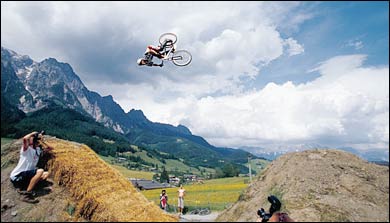LAST JULY 13, as a pack of Tour de France racers crested the 8,678-foot Col du Galibier, 27-year-old Canadian Dave Watson launched his Kona Stab Primo mountain bike off a hill 30 feet above the route. He sailed over the riders and crashed on the far side of the road, flipping over the handlebars but suffering only minor injuries.
The stunt, celebrated in newspapers and magazines worldwide, was the most high-profile indication yet that the once-fringe freeriding movement has become mountain biking’s driving force for image and R&D. Inspired by motocross and BMX, elite freeriders like Watson and his colleagues on the Kona Clump Team—an oft-injured crew that spurns races for gonzo tricks—are redefining what’s possible on two fat tires, and bringing bike manufacturers and gravity-sports addicts along for the ride.
The buzz is badly needed. Membership in the National Off-Road Bicycle Association (NORBA), pro mountain-bike racing’s sanctioning body in the U.S., has fallen 61 percent since 1993. In 2002, NORBA lost its chief sponsor, Chevy Trucks, and its broadcast partner, the Outdoor Life Network, which aimed more lenses at the Tour de France. Mountain-bike sales have also dropped, from 65 percent of all bikes sold by independent dealers in 1994 to 41 percent in 2003. Part of the problem, says Zapata “Zap” Espinoza, 43, a veteran biking writer who’s now brand manager for Trek, is saturation—mountain bikes became so ubiquitous, they lost their cachet.
Injecting X Games energy into mountain-biking events is one way to regain mojo. In the world’s one big-time freeriding contest, the four-year-old Red Bull Rampage, bikers bounce down ledges on a trail-less mountain outside Utah’s Zion National Park, and are judged on criteria like amplitude. While weekend riders will stay closer to earth, major manufacturers are jumping aboard, pairing heavy-duty frames with shocks that deliver an astounding nine inches of travel. Five years ago, small Canadian companies were selling beefy parts to pioneers ripping up Vancouver’s North Shore. In January, Shimano introduced its Saint line, the first widely available freeride components kit. “It’s where all the development is happening,” says Kevin Franks, global sports marketing manager for Specialized.
Mountain resorts are also betting on a resurgence. In June, British Columbia’s Whistler Blackcomb will open up six new jump-riddled trails on its biking terrain. Developers at Tamarack, a new resort set to open in west-central Idaho next winter, built a bike park with berms and kickers before even erecting lift towers. Given the tantalizing prospect of attracting the same crowds that mob snowboarding halfpipes every winter, it’s hard to blame them.
“With freeriding, you don’t have to be the marathon-runner type to get into mountain biking anymore,” says Rob McSkimming, 47, the manager of the Whistler Blackcomb bike park. “You can be a throttle twister.”
Ready for Takeoff
Renegade freeriders are launching mountain biking into the X Games era

(Photo: John Gibson)
New perk: Easily find new routes and hidden gems, upcoming running events, and more near you. Your weekly Local Running Newsletter has everything you need to lace up! .
From ���ϳԹ��� Magazine, Apr 2004
Lead Photo: John Gibson

